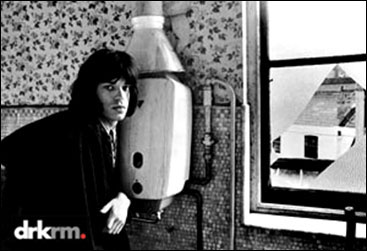| |
ALIEN
SEX
Donald Cammell thought Mick Jagger to be a more
provocative rock star than Elvis Presley because Jagger was willing
to experiment with his masculinity. Elvis, although extraordinarily
erotic to a generation of young women, never did. What this difference
suggests, among other things, is that Mick Jagger’s appeal is
not Elvis’s—and never was. Critic Greil Marcus has argued
that what Elvis did was to purge the Sunday morning sobriety from folk
and country music and to purge the dread from blues; in doing so, he
transformed a regional music into a national music, and invented party
music. Elvis popularized an amalgam of musical forms and styles into
“rock ‘n’ roll,” a black American euphemism
for sexual intercourse. What the Rolling Stones did to rock music, some
years after Elvis made sex an integral part of its appeal, was to infuse
rock with a bohemian theatricality, at first through Brian Jones, who
was the first British pop star to cultivate actively a flamboyant, androgynous
image. For a time, Brian even found his female double in Anita Pallenberg.
Brian Jones and the Stones thus re-introduced into rock music its erotic
allure, and hence made it threatening (again).
The cultivated androgyny and transvestitism of 1960s pop stars such
as Mick Jagger and David Bowie destabilized and subverted stable categories
of the self and sexual identity, which is why as cultural practices
they were perceived by some as so threatening and so subversive to genteel,
bourgeois culture. By the late 1960s and early 1970s, rock music had
become synonymous with decadence. Hence, upon its release in 1970, Performance
was either demonized and denounced (by the conservative press) or traduced
(by the liberal press). It conformed to neither a conservative nor a
liberal simulacrum of the world—nor does it now. The same critical
reception greeted The Man Who Fell to Earth upon its release
in the United States in 1976. As an alien, Thomas Jerome Newton was
similar to the Michael Rennie character (Klaatu, aka “Mr. Carpenter”)
in The Day the Earth Stood Still (1951) by virtue of his possessing
advanced technology. He was utterly unlike the Rennie character, however,
in that his alien sexuality was foregrounded; it was essential to defining
his difference. Moreover, he was possibly a bisexual being as well.
Yet in addition to the androgynous figure of David Bowie, there was
Candy Clark, no longer the winsome Sandra Dee-like figure she had portrayed
in American Graffiti (and nothing, say, like Patricia Neal
in Day the Earth Stood Still, either) but a single, unattached
girl who liked to party, pretty and with a kind heart, going nowhere,
but with a strong work ethic—who dared to have sex with an alien.
There has been much emphasis in critical discussion of The Man Who
Fell to Earth on David Bowie’s ambiguous sexuality, the effect
of which has obscured the extraordinary performance of Candy Clark,
who was willing to allow her slow moral corruption, like Dorian Gray’s,
to be signaled by her increasingly unattractive, de-glamorized body.
Her performance represents one of the great subversions of science fiction
cinema by suggesting that not only was she, as a woman, willing to experiment
sexually, but eventually leave Thomas Jerome Newton because of sexual
incompatibility. The Man Who Fell to Earth actualized, in a
rather perverse way, the romance that was repressed in (among other
science fiction films) The Day the Earth Stood Still. In addition,
while the perceived threat to civil order in these films resided in
part because they broke aesthetic taboos, time has also revealed something
else that is compelling about them: they are both spiritual allegories,
albeit unorthodox ones. The Man Who Fell to Earth enacts the
Gnostic, or at least Neo-Platonic, journey of the human soul, fallen
to earth, the material and hence evil world, from which it strives to
free itself and return home, to heaven. But this is a world of corruption,
deception, and betrayal; the devil wears many guises, and the path home
is very, very hard to find. (Interestingly, when asked what he thought
the allegorical dimension of The Man Who Fell to Earth was,
the novel’s author, Walter Tevis, himself an alcoholic, said “alcoholism.”)
Donald Cammell said his goal in making Performance was to make
a “transcendent” movie in which death is seen not as an
end but as the beginning of a new existence—suggesting the way
that Performance is also Neo-Platonic in its underlying (and
unorthodox) religious premises. One of Donald Cammell’s favorite
films, a film which truly fascinated him, was Jean Cocteau’s Le
Sang d’un poète (Blood of a Poet, 1930), in which
the poet-martyr, or artist, commits successive suicides in order to
find his true form, ultimately achieving immortality, paradoxically,
only through death. In Cocteau’s own discussion of the films comprising
his “Orphic Trilogy” (Le Sang d’un poete, Orphée,
and The Testament of Orpheus) he identified one particular theme
that would have strongly appealed to Donald Cammell: “The successive
deaths through which a poet must pass before he becomes, in that admirable
line from Mallarmé, tel qu’en lui-même enfin l’éternité
le change—changed into himself at last by eternity.” The
mystery and allure of these films is traced in the provocative images
on display here, a testament to the sustained imaginative power of these
two remarkable films directed by Donald Cammell and Nicolas Roeg.
––Sam Umland is the Co-author, with Rebecca Umland, of Donald
Cammell: A Life on the Wild Side (FAB Press 2006) and a Professor
of English at the University of Nebraska at Kearney.
top
|
|
